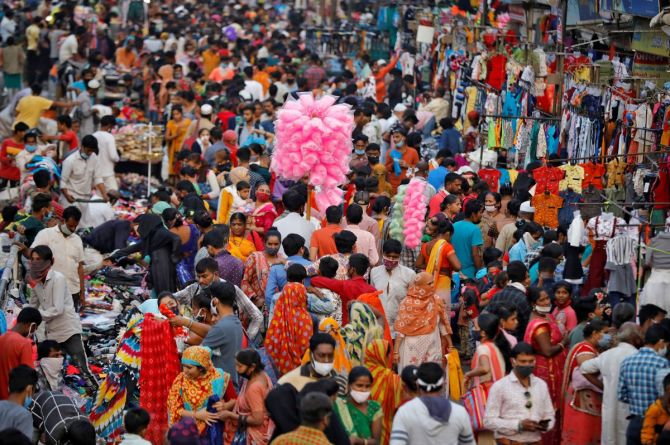The return of the unemployment rate to pre-lockdown times is not worth celebrating because it is more a reflection of a shrinking labour force than a decline in the count of the unemployed, observes Mahesh Vyas.

India pencilled an unemployment rate of 6.9 per cent in February 2021.
This was higher than the 6.5 per cent unemployment rate recorded in January 2021, but lower than the 9.1 per cent India had touched in December 2020.
The unemployment rate has ranged from 6.5 per cent to 9 per cent in the post-lockdown period since July 2020.
The February 2021 rate is a little lower than the 7.3 per cent average during this period.
It is also lower than the February 2020 unemployment rate, which was 7.8 per cent.
The average unemployment rate during the post-lockdown period since July 2020 at 7.3 per cent is a little lower than the 7.6 per cent average unemployment rate recorded in the corresponding months of the previous year.
The unemployment rate has, therefore, recovered to its pre-lockdown levels.
However, other more important labour market parameters have worsened.
The two other important labour market ratios are the labour force participation rate (LPR) and the employment rate (ER).
Both remain significantly lower than their levels before the lockdown.
A recovery in these two ratios to pre-lockdown levels is still a distant dream.
More realistically, it may not be misplaced pessimism to lament that given the secular decline in labour market indicators even before the lockdown, a recovery in the LPR and ER to pre-lockdown levels may not be just a distant dream but it could be an elusive dream.
In February 2021, the LPR was 40.5 per cent. This was slightly lower than the 40.6 per cent recorded in January 2021 and 42.6 per cent in February 2020.
This means that the proportion of working-age people who are employed or are unemployed and actively seeking employment has declined.
The return of the unemployment rate to pre-lockdown times is not worth celebrating because it is more a reflection of a shrinking labour force than a decline in the count of the unemployed.
During July-February last fiscal, the unemployment rate of 7.6 per cent was a ratio of the 33.2 million unemployed out of a labour force of 438.5 million.
During July-February this fiscal, a similar unemployment rate of 7.3 per cent is a ratio of 31.2 million unemployed out of a much smaller labour force of 426.3 million.
The small fall in the unemployed we see does not imply that more people got employment.
It means that the unemployed just stopped looking for jobs.
It reflects an exodus of labour from the labour markets in the face of lack of jobs.
The count of the employed, which is the larger component of the labour force, has declined quite sharply.
Again, we compare the eight months post the severe lockdown of this fiscal -- July 2020 through February 2021 -- to the corresponding eight months of the previous year.
During July-February of the previous fiscal, on average, 405.3 million persons were employed.
In comparison, during the corresponding period of the current year, 395.2 million persons were employed.
This implies over 10 million less jobs this year than the previous.
So, the post-lockdown period is characterised by a 2.5 per cent fall in employment and 6.2 per cent fall in the count of the unemployed.
This translates into a 2.8 per cent contraction of the labour force.
The Indian economy has emerged from the dark, deep abyss of the lockdown.
Official statistics show a small positive growth of 0.4 per cent y-o-y, in real GDP in the third quarter.
But employment has not recovered similarly.
It was down by 2.8 per cent. India has faced a multi-decadal challenge in generating employment commensurate with its real GDP growth.
It would take a much faster GDP growth or a more labour-intensive GDP growth to bring employment growth into the positive zone like the GDP has been reverting to very quickly.
Else, employment will continue to decline.
Total employment in India declined from 413 million in 2016-2017 to 409 million in 2019-2020.
This is a time when the economy was growing at about 6 per cent per annum on average.
Employment needs to grow at least at a pace to keep the employment rate constant.
The employment rate is the proportion of the working-age population that is employed.
So, what we are saying is that employment needs to grow at least enough to keep pace with the rate at which the working-age population is growing.
This could ensure that the situation wouldn't get worse from where India stands today.
India's employment rate has been falling steadily.
It fell from 42.7 per cent in 2016-17 to 41.6 per cent, 40.1 per cent and 39.4 per cent in the following three years till 2019-20.
As of February 2021, it dropped even further to 37.7 per cent.
The slide in the employment rate continues. The rate has recovered from the steep fall earlier in fiscal 2020-21.
But, it has merely reverted to its trend of a steady fall that was established before the lockdown.
The post-lockdown recovery in the employment rate is not to the pre-lockdown levels but to the earlier trend of a slow and steady fall.




Mahesh Vyas is MD and CEO, CMIE P Ltd.











